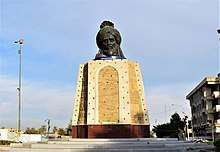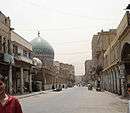Mansour district
Al Mansour [1] (Arabic: المنصور) is one of the nine administrative districts in Baghdad, Iraq. It is in western Baghdad and is bounded on the east by Karkh district in central Baghdad, to the north by Kadhimiya, to the west by Baghdad International Airport, and to the south by Baghdad Airport Road, on the other side of which is Al Rashid district.

Description

Al Mansour is named after Abu Ja'far al-Mansur, the second Abbasid Caliph and founder of Baghdad. Mansour was traditionally an affluent area where wealthy Arab families lived. It was also known as the "embassies district" due to the many foreign embassies situated there. It is known to be an avid shopping district which attracts those seeking luxury imported goods, modern market places, and services including restaurants, cafes and entertainment. However, during the sectarian unrest which occurred between 2006 and 2007, it became a place of extreme contention and violence, resulting in street violence and bombings which displaced much of the population at the time resulting in extensive damage and a depopulation of citizens due to the Sunni majority at the time leaving the district.[2] Gradually, as the situation in Baghdad stabilized, markets, shopping malls, and luxury goods returned to the area.[3]
Al-Mansour statue
A bronze bust of Abu Ja'far al-Mansur was erected in the Mansour district in 1976 and was designed to serve as a link between Iraq's illustrious past and its bright future.[4] The work of Iraqi sculptor, Khaled al-Rahal, the bust was irreparably damaged by bomb blast in 2003 and was dismantled in 2005.[5]
Neighborhoods
- 62.Qadissiya
- 63.Mansour neighbourhood, Dragh, Baghdad International Fair
- 64.Al-Washash
- 65.Iskan
- 66.14 Ramadan
- 67.Yarmouk
- 68.Safarat complex, Kafa'at
- 69.Al-A'amiriya
- 70.Al Khadhraa, Hayy Al-Jami'a
- 71.Al-Adel
- 72.Ghazaliya East
- 73.Ghazaliya west
- 74.Baghdad Airport-Abu Ghrib road
See also
References
- Salbi, Zainab (2009-09-04). "Little House in the War Zone". New York Times.
- "Baghdad Neighbourhoods", Institute for the Study of War, Online:
- "In Baghdad, Iraqis embrace return to normalcy, with eye on its fragility", Christian Science Monitor, 7 May, 2018, Online:
- Baram, A., Culture, History and Ideology in the Formation of Ba'thist Iraq, 1968–89, Springer, 1991, p. 77; Nada Shabout, "The 'Free' Art of Occupation: Images for a 'New" Iraq,' Arab Studies Quarterly, Vol. 28, No. 3/4, pp. 41–53, Online:
- "Mosque Blast Blow to Iraq treasures," Al Jazeera, Online:
